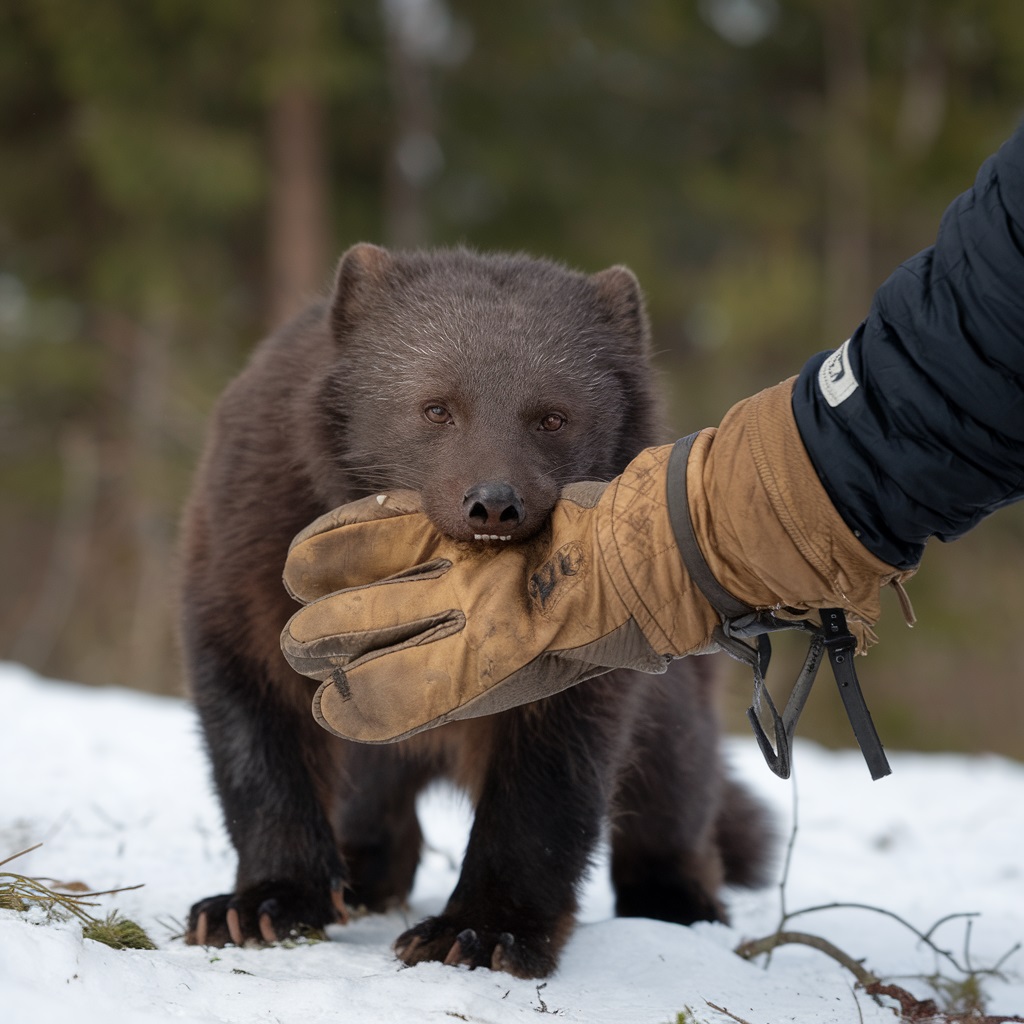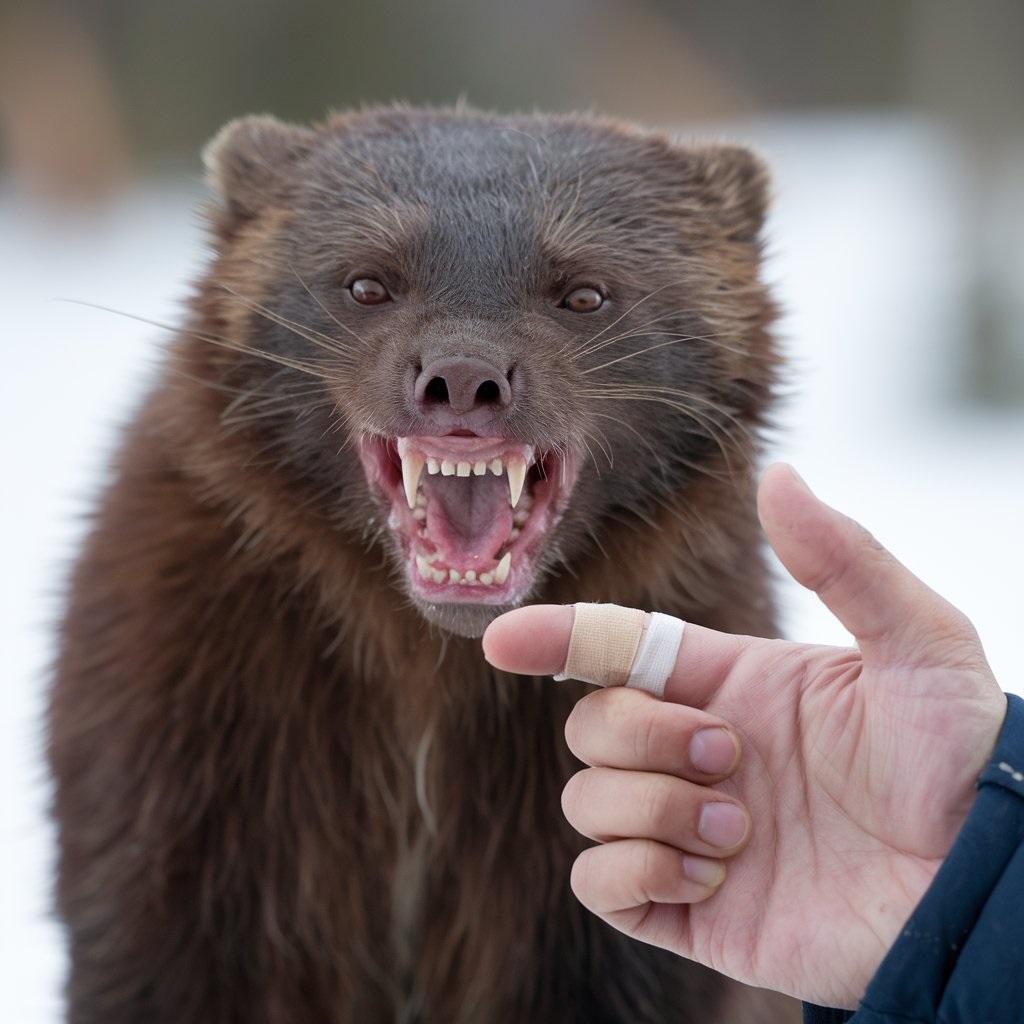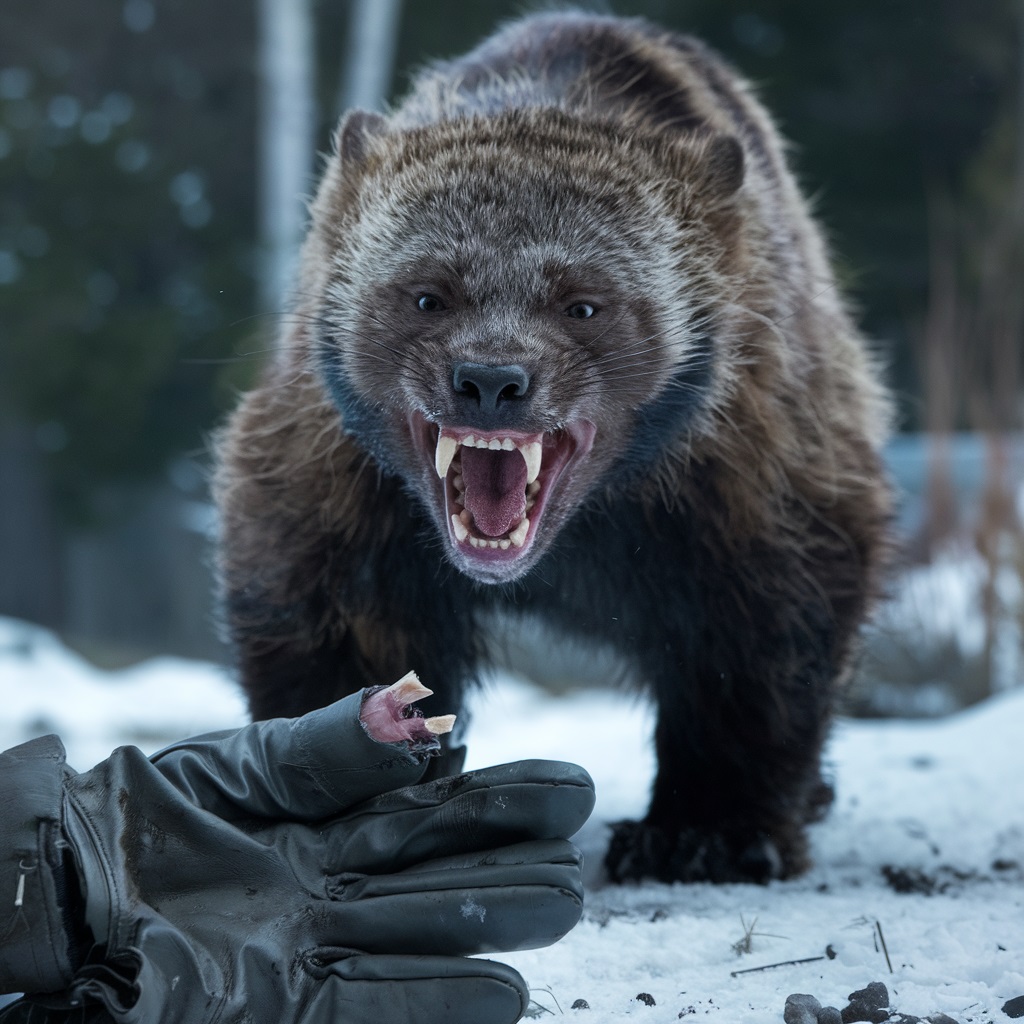Do Wolverines Attack Humans? This is a common question that many outdoor enthusiasts, wildlife lovers, and curious minds often ask. Wolverines, known scientifically as Gulo gulo, are notorious for their fierce nature and strength, but how dangerous are they to humans? While these powerful animals are more likely to avoid people, their behavior can change in certain circumstances.
Wolverines are highly territorial and defensive, and when threatened, they might attack. In this post, we will dive deep into the wolverine’s characteristics, its behavior towards humans, the rare circumstances leading to aggression, and how you can stay safe if you ever encounter one in the wild.
Sure! Here’s a table summarizing the key facts and figures from the article:
| Fact/Feature | Details |
|---|---|
| Scientific Name | Gulo gulo |
| Physical Characteristics | Stocky, muscular build, broad head, sharp claws, powerful jaws, thick fur. |
| Weight | 20–55 pounds |
| Habitat | Boreal forests, tundra, mountainous regions in Alaska, Canada, Scandinavia, and Russia. |
| Preferred Environment | Remote wilderness, deep snow cover, cold climates |
| Life Expectancy | 7–13 years in the wild |
| Diet | Carnivorous, scavenger of larger predators’ leftovers, and capable of hunting smaller prey. |
| Behavior | Solitary, highly territorial, reclusive, and defensive when threatened. |
| Defensive Features | Powerful jaws capable of crushing bone, sharp claws for defense and mobility, thick fur for insulation. |
| Known Threats | Habitat loss, climate change, human encroachment. |
| Wolverine Attacks on Humans | Extremely rare; typically occur when the animal feels threatened or provoked. |
| Attacks in Documented Cases | Alaska (2004) and Canada (2010), usually in self-defense or territorial defense. |
| Average Lifespan in Captivity | Up to 15 years |
| Size Comparison | Smaller than wolves, bears, and mountain lions but much stronger for its size. |
| Territorial Range | Up to 500 square miles for males, 100-300 square miles for females. |
| Survival Tactics | Wolverines can cover great distances in search of food, capable of traveling across snow-covered landscapes. |
| Human Encounters | Rare and usually non-aggressive; most attacks are defensive, not predatory. |
What Are Wolverines?
Wolverines, known scientifically as Gulo gulo, belong to the Mustelidae family, which also includes ferrets, otters, and martens. However, unlike many of their smaller cousins, wolverines are remarkably strong and independent. These stocky animals are perfectly suited to surviving in some of the harshest environments on Earth. But what makes these animals truly fascinating is how their physical attributes and natural behaviors enable them to thrive in environments where few others could.

Physical Characteristics
Wolverines are built like miniature powerhouses, designed to survive the toughest conditions. Typically weighing between 20 to 55 pounds, they possess a muscular body, a broad head, sharp claws, and powerful jaws capable of crushing bones. Their thick, dark fur provides vital insulation in cold climates, allowing them to inhabit environments where temperatures drop well below freezing.
Here’s a breakdown of their notable features:
- Powerful Jaws and Sharp Claws: Wolverines have jaws capable of crushing bone and claws used for mobility, hunting, and defending themselves. Their sharp claws are also vital for climbing steep slopes or digging through deep snow to find food.
- Thick Fur for Cold Environments: The thick fur that covers their bodies is more than just for warmth. It also helps protect them from the harsh elements they face in remote wilderness areas, where temperatures often reach extremes.
- Small but Muscular Build: While they are not as large as wolves or bears, wolverines are muscular and well-equipped to survive in areas that require strength and agility. Their broad head and stout legs allow them to take on prey much larger than themselves, including carcasses from animals like moose and caribou.
Despite their smaller size compared to apex predators, wolverines are ferocious and determined survivors, making them one of the most intriguing animals in the wild.
Habitat and Behavior
Wolverines are known for their wide-ranging territories and ability to thrive in some of the most inhospitable environments on Earth. Found primarily in the Northern Hemisphere, they roam across remote wilderness areas in places like Alaska, Canada, Scandinavia, and Russia. These animals are skilled at surviving in extreme cold and are often found in regions with heavy snow cover and rugged terrain.
Where Do Wolverines Live?
Wolverines are adaptable and can live in a variety of habitats, though they tend to prefer areas that offer the solitude and resources they need to thrive. Here are some key habitats where wolverines are commonly found:
- Boreal Forests: These forests are prevalent in the northern latitudes and are characterized by coniferous trees, deep snow, and harsh winters. Wolverines thrive here, taking advantage of the abundance of small prey and the occasional opportunity to scavenge from larger predators like wolves and bears.
- Mountainous Regions: Wolverines are excellent climbers, and their muscular build helps them navigate rugged terrains. They are commonly found in mountain ranges where they can access both food sources and seclusion.
- Tundra: The cold, treeless landscapes of the tundra offer a unique environment for wolverines. Though the tundra may seem barren, it offers wolverines ample space to roam in search of food, especially during the winter months when larger animals are scarce.
Solitary Behavior and Territoriality
Wolverines are fiercely territorial animals that rely on large home ranges to secure their survival. Unlike pack animals like wolves, wolverines prefer solitude and are more likely to travel alone or in small family units. Their territory is marked by scent trails, which they use to communicate with other wolverines and keep competitors at bay.
Wolverines are known to be highly defensive of their food sources. They are scavengers, often eating whatever they can find—whether it’s the leftovers from larger predators or smaller prey that they catch themselves. Their aggressive defense of food caches and dens is a key behavior trait that helps them survive in harsh conditions.

Do Wolverines Attack Humans?
While wolverines are often portrayed as aggressive creatures, their encounters with humans are rare. Most wolverines are shy and avoid contact with humans, preferring the remoteness of their wilderness habitats. However, their behavior can change if they feel threatened or cornered, especially in situations where their territory or young are at risk.
General Behavior Toward Humans
In general, wolverines are not inclined to attack humans. They are reclusive and prefer to avoid interaction with people. However, they may become aggressive if they feel threatened or cornered. This defensive behavior is particularly noticeable when wolverines are:
- Protecting Their Territory: Wolverines are known to defend their home ranges against intruders. A wolverine may perceive a human entering its territory as a threat, which could trigger a defensive response.
- Protecting Their Offspring: Female wolverines with young are particularly protective and will fight to protect their dens if they feel they or their offspring are in danger.
- Threatened or Surprised: If a wolverine feels cornered, it may attack as a last resort, particularly if it perceives no other option for escape.
Rare Attacks on Humans
Documented cases of wolverine attacks on humans are exceedingly rare. However, there have been instances in which wolverines have acted aggressively, usually in situations where the animal felt threatened or provoked.
Notable Cases of Wolverine Attacks:
- Alaska, 2004: A hiker in a remote part of Alaska had a close encounter with a wolverine near its den. The hiker, unaware of the animal’s presence, was attacked after the wolverine perceived the intrusion as a threat. Thankfully, the hiker was able to use bear spray to defend themselves and escape without severe injury.
- Canada, 2010: A couple camping in a remote area of Canada reported an incident in which a wolverine became aggressive after they tried to retrieve a food cache. The wolverine charged the campers, but no serious harm was done. The campers wisely used their bear spray to deter the animal.
These documented attacks show that while wolverines are capable of aggression, these incidents are typically defensive in nature rather than predatory. Wolverines do not actively seek out humans to attack but may strike when they feel threatened.
Are Wolverine Attacks Dangerous?
Wolverines may be small in size, but they are powerful predators. Their strong jaws and sharp claws are capable of inflicting serious injury. However, it’s important to understand that wolverine attacks on humans are highly unlikely and typically occur only when the animal is provoked or feels cornered.
Potential Harm from Wolverine Attacks
The injuries caused by a wolverine attack are usually not fatal but can be painful and serious. These may include:
- Puncture Wounds: Wolverines’ claws and teeth are incredibly sharp, and a single swipe can result in deep puncture wounds.
- Lacerations: A wolverine’s sharp claws are designed to tear through flesh, and an attack can leave significant cuts or gashes.
- Crushed Bones: Due to their powerful jaws, wolverines can easily crush bones, especially if they feel threatened. A bite to an arm or leg could cause significant damage.
Despite the potential harm, the real risk of a wolverine attack is low. Most attacks are preventable by taking basic precautions and understanding the animal’s behavior.

Surviving a Wolverine Encounter
If you find yourself in the rare situation of encountering a wolverine, it’s essential to know how to protect yourself. Here are the best practices to ensure your safety:
Steps to Take:
- Stay Calm: Panicking may provoke the animal further. Try to remain still and calm. Wolverines can sense fear, so avoid sudden movements.
- Make Yourself Look Larger: If the wolverine seems threatened, raise your arms or open your jacket to make yourself appear larger. This will help intimidate the animal.
- Back Away Slowly: Always back away slowly. Don’t turn your back on the animal, and never run, as this may trigger a chase response.
- Use Bear Spray: If the wolverine continues to approach or shows signs of aggression, use bear spray to deter it. Aim for the face to repel the animal effectively.
How to Avoid Wolverine Encounters
While wolverine attacks are rare, it’s always better to be prepared when exploring their habitats. By following simple guidelines, you can minimize your risk of encountering a wolverine in the wild:
Safety Guidelines:
- Stick to Trails: Stay on well-established trails to reduce your chances of wandering into wolverine territory. Keep your distance from dense forests and secluded areas.
- Keep Pets on a Leash: Wolverines may view smaller animals as prey, so always keep your pets on a leash to avoid drawing their attention.
- Avoid Wolverines’ Dens and Food Caches: If you stumble upon a wolverine den or food cache, back off immediately. These areas are often fiercely guarded by the animal.
- Travel in Groups: Traveling with others is an effective deterrent. Wolverines are more likely to avoid groups of humans, which reduces the risk of an encounter.
What to Do If You See a Wolverine
If you spot a wolverine from a safe distance, it’s important to act calmly and respectfully:
- Do Not Approach: Wolverines are naturally shy and should not be approached. Respect their space and avoid disturbing them.
- Remain Quiet: Loud noises can startle the animal. Keep your voice low and avoid making sudden movements.
- Report Sightings: If you see a wolverine in a populated area or near human activity, report the sighting to local wildlife authorities so they can monitor the animal’s movements.

FAQs
1. Could a wolverine kill a human?
Wolverines are not known to attack humans in the wild, and there is no evidence of fatal encounters, though they may display aggression when threatened.
2. Are wolverines aggressive?
Wolverines are fierce, territorial creatures, known for their power and tenacity, often hunting and scavenging with aggression.
3. Can you outrun a wolverine?
Despite their robust build and size, wolverines are fast and can outrun humans, making it difficult for anyone to escape if a confrontation occurs.
4. What’s the biggest animal a wolverine can kill?
Wolverines can take down large animals like moose or caribou in rare instances, especially when the prey is vulnerable.
5. Can a wolf beat a wolverine?
A pack of wolves could overpower a wolverine due to their numbers, but wolverines tend to scavenge from wolf kills rather than engaging in direct conflict.
6. Can a wolverine be a pet?
It is illegal to keep a wolverine as a pet, as they are wild animals managed by wildlife authorities.
7. Which is more aggressive, a wolverine or a badger?
Wolverines are slightly larger and more aggressive than badgers, making them the more formidable of the two.
8. Is the wolf an apex predator?
As apex predators, wolves dominate their ecosystems, effectively controlling prey populations and maintaining balance.
9. What animal will eat a wolverine?
Wolves, bears, and cougars can prey on wolverines, particularly young individuals or those that are vulnerable.
10. What is the toughest animal?
The tardigrade, a microscopic creature, is considered the toughest due to its ability to survive extreme conditions like dehydration and freezing.
11. Who would win in a fight, a husky or a wolverine?
A wolverine could easily defeat a pack of huskies, showcasing its unmatched strength and toughness in North America.
12. Can a wolverine take a bullet?
In fiction, Wolverine is portrayed as invulnerable, but in reality, his healing powers don’t make him impervious to bullets.
13. Can a wolverine be tamed?
Though known for their wild nature, wolverines can be tamed with patience and care, becoming loyal companions in some cases.
14. Do wolves eat wolverine?
While wolves may kill wolverines, they usually do so in territorial disputes rather than for food, as they don’t consume their prey.
15. How intelligent are wolverines?
Wolverines are highly intelligent, adaptable animals that display curiosity and problem-solving skills in their environment.
16. Why is wolverine so rare?
Wolverines face threats from climate change, habitat destruction, and human activities, making them a rare and vulnerable species.
17. What animal is mistaken for a wolverine?
Marmots and porcupines are often confused with wolverines, especially based on their tracks and appearance in the wild.
Final Verdict: Do Wolverines Pose a Real Threat to Humans?
In conclusion, wolverines are not a significant threat to humans. While their reputation as fierce, aggressive creatures may be warranted in certain contexts, wolverines prefer to avoid human interaction. Most attacks, though rare, are defensive and occur when a wolverine feels threatened, cornered, or is protecting its territory or offspring.
By understanding wolverine behavior and taking proper precautions, you can ensure a safe encounter with these remarkable creatures. Respect their territory, space, and habitat, and you’ll have a much safer and more enjoyable experience in the wild.
Read more knowledgeable blogs on Flowy Magazine

James Clair is a passionate writer and researcher with a deep fascination for animal behavior and its intricate connection to human life. With a background in [relevant field of study, e.g., zoology, psychology, ethology], James has spent years studying the natural world, focusing on how animals’ actions and instincts impact human emotions, behavior, and society.
His expertise in [specific topics or regions of focus, e.g., canine psychology, animal communication, wildlife conservation] has led to numerous published works and collaborations with renowned researchers and institutions. Through his work at Flawy Magazine, James aims to bridge the gap between scientific research and public understanding, offering insightful, accessible articles that explore the complex relationship between humans and animals.
When he’s not writing, James enjoys [personal hobbies or interests, e.g., hiking in nature, volunteering at animal shelters, photography] and is an advocate for [cause or charity related to animals or conservation]. His mission is to inspire readers to see animals not just as companions or creatures of the wild, but as beings whose behavior holds valuable lessons for us all.









